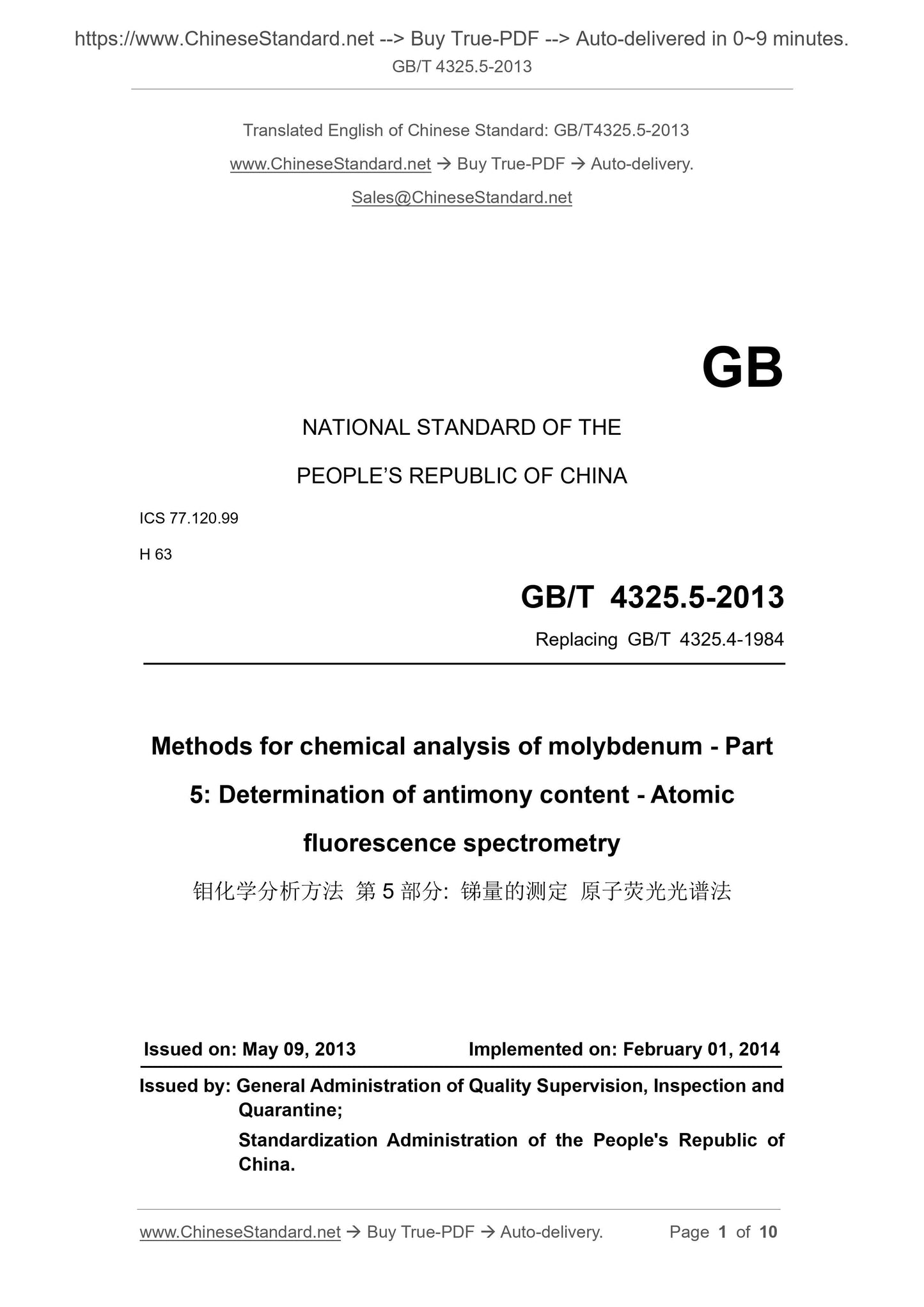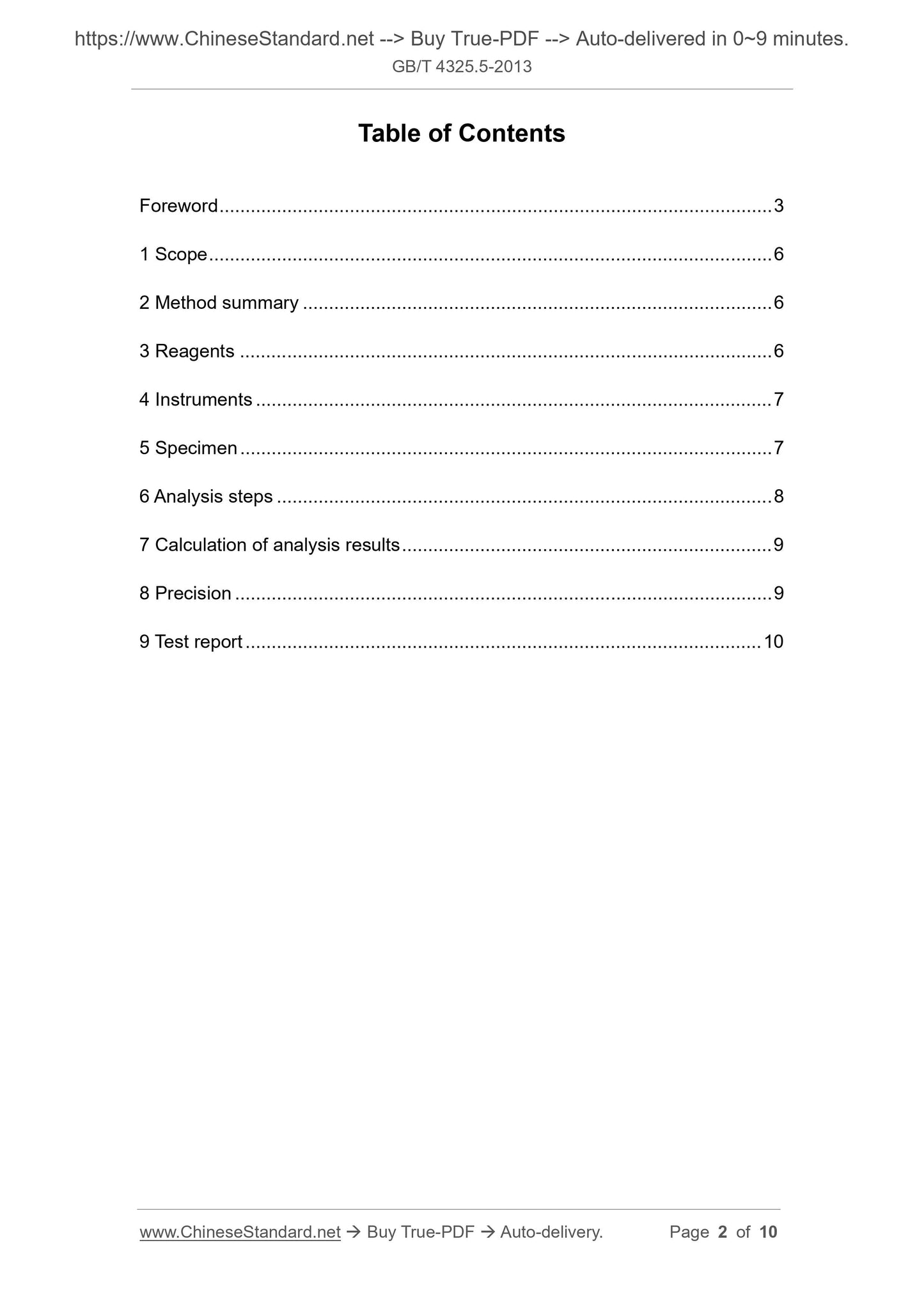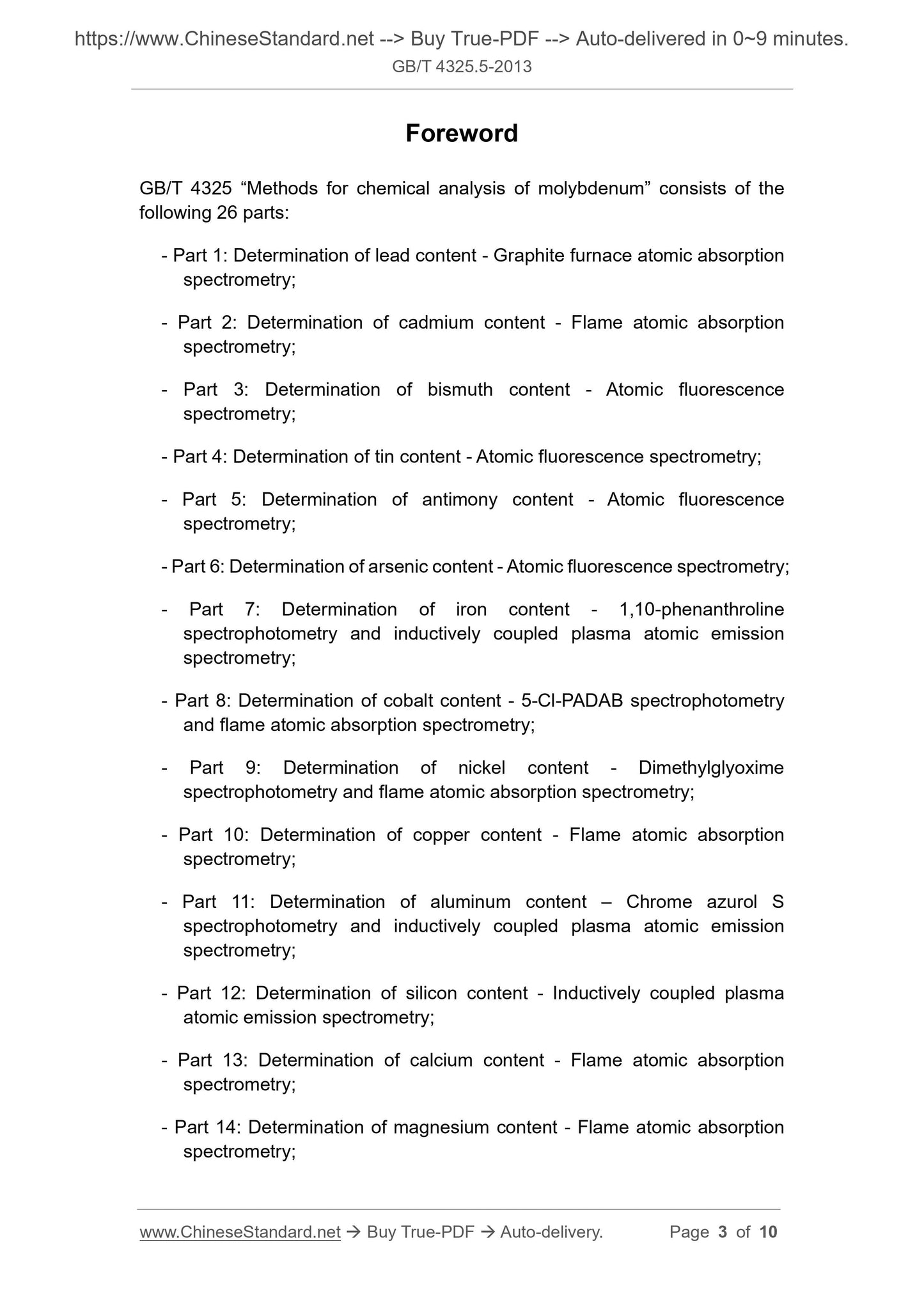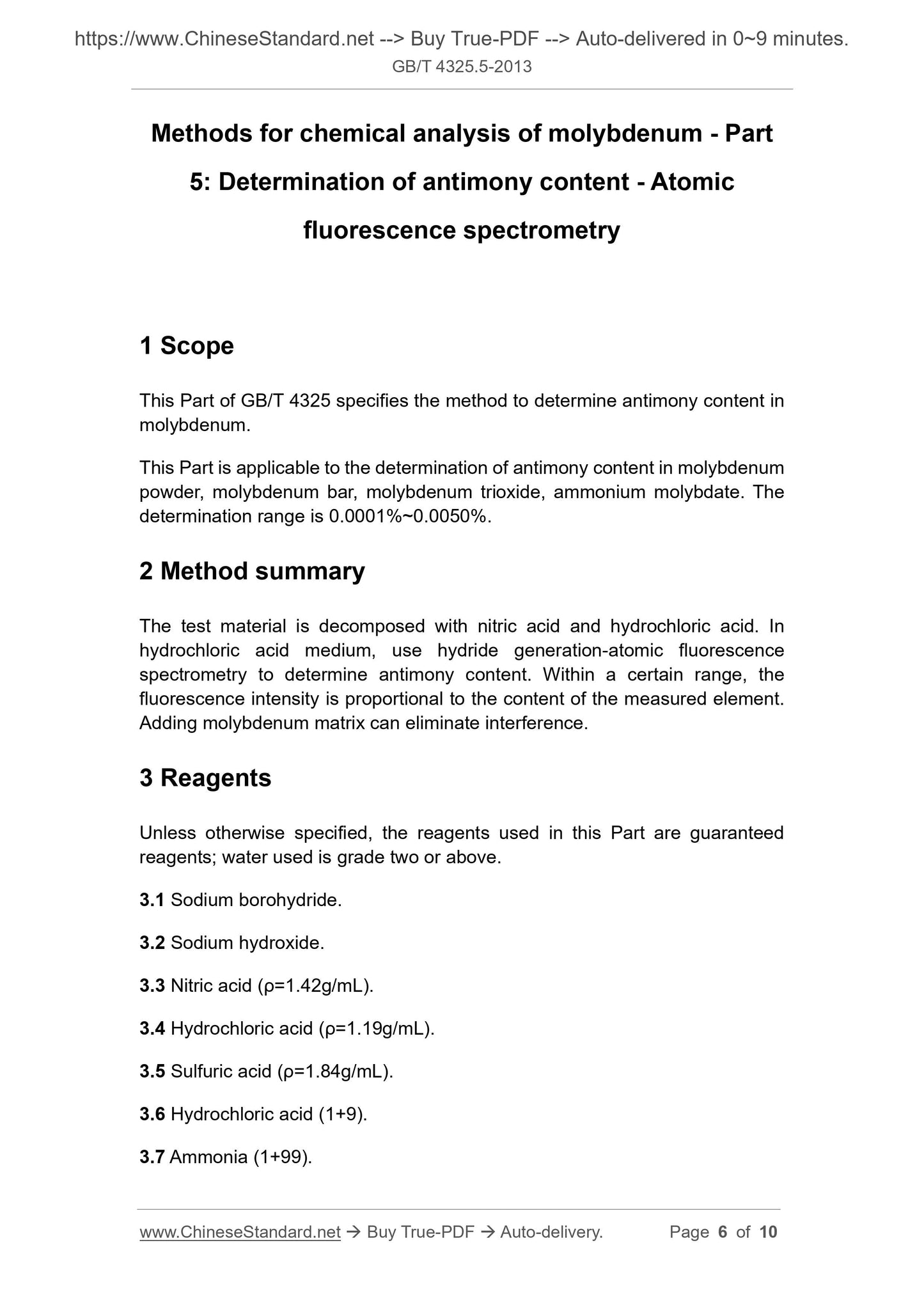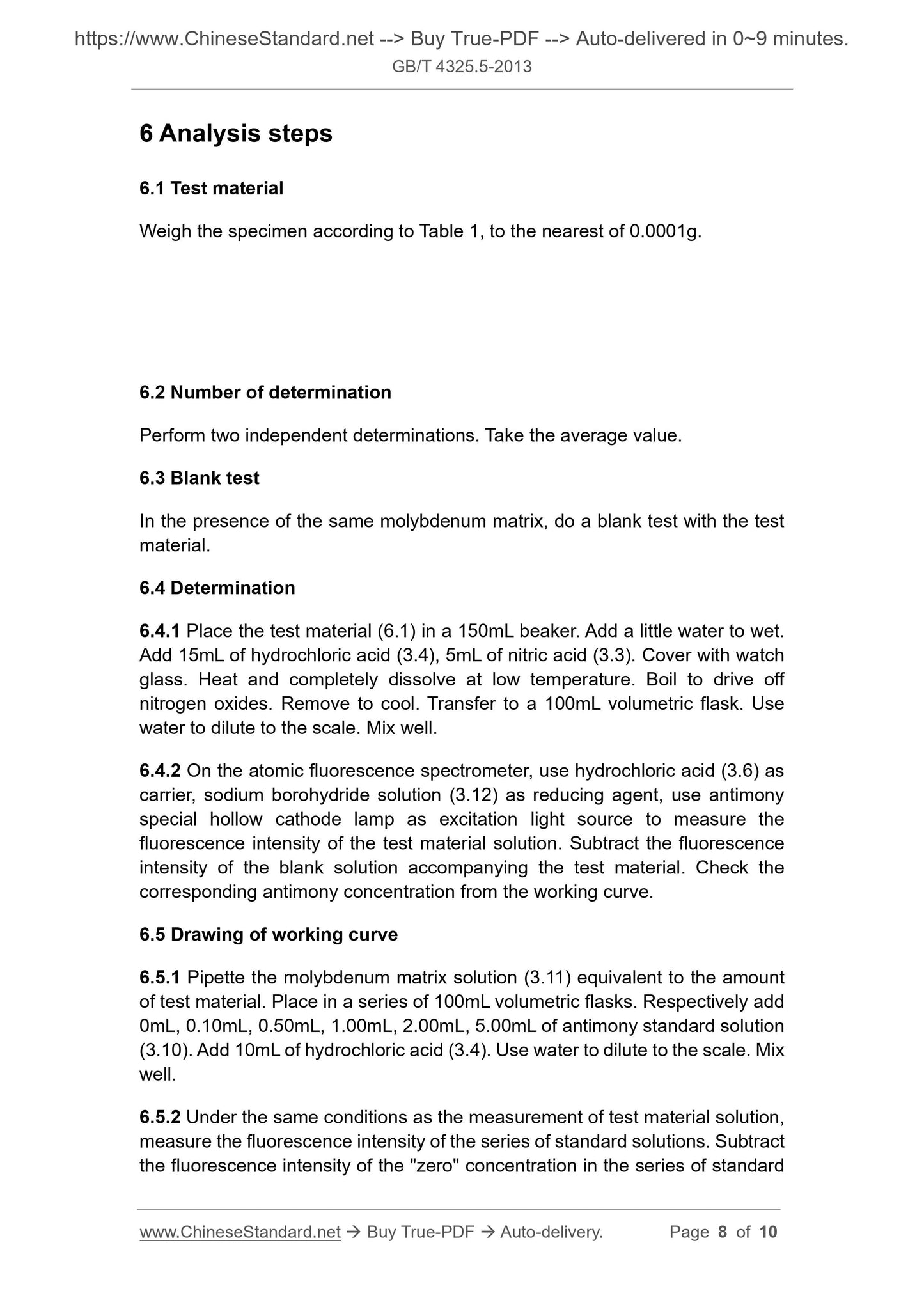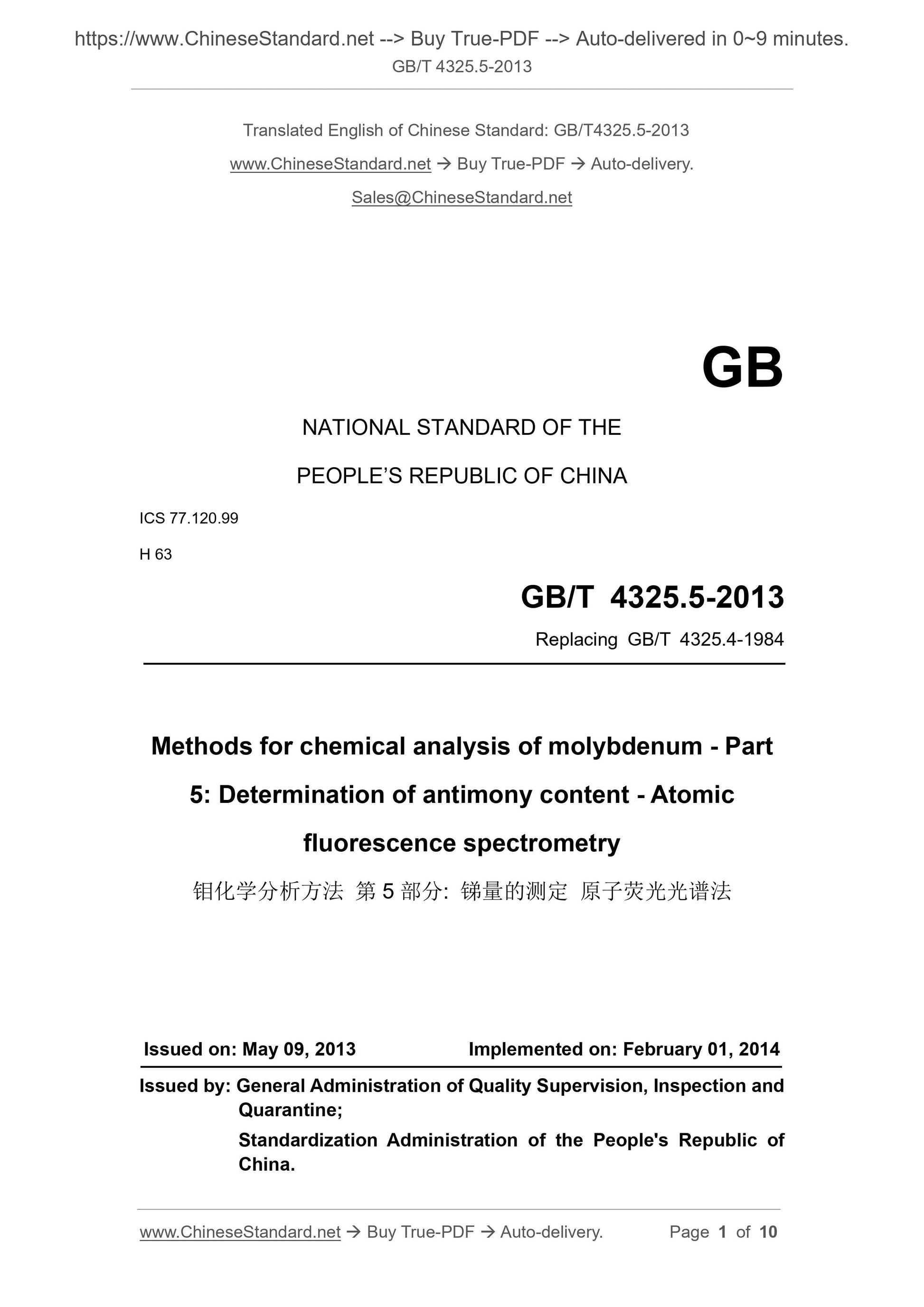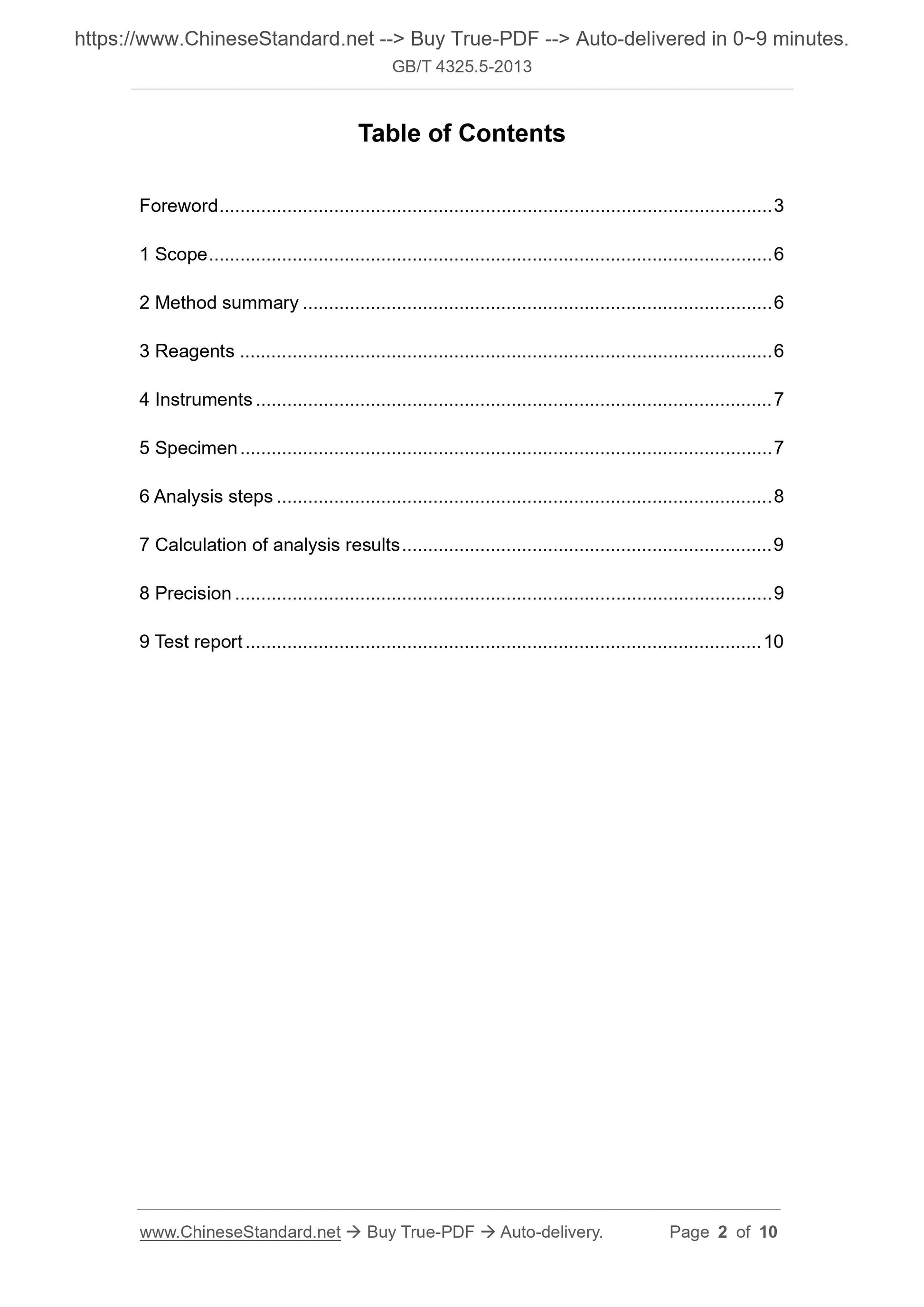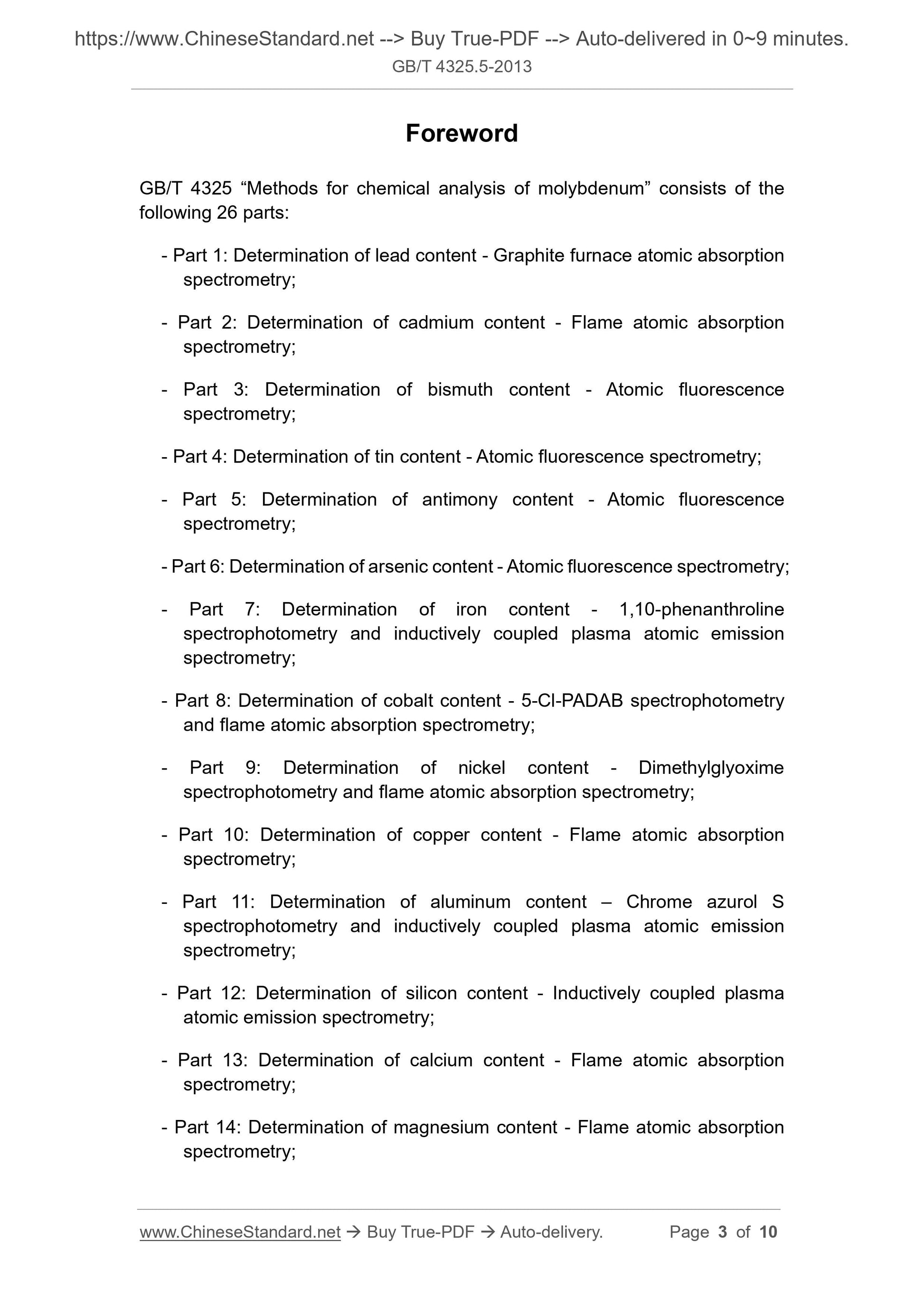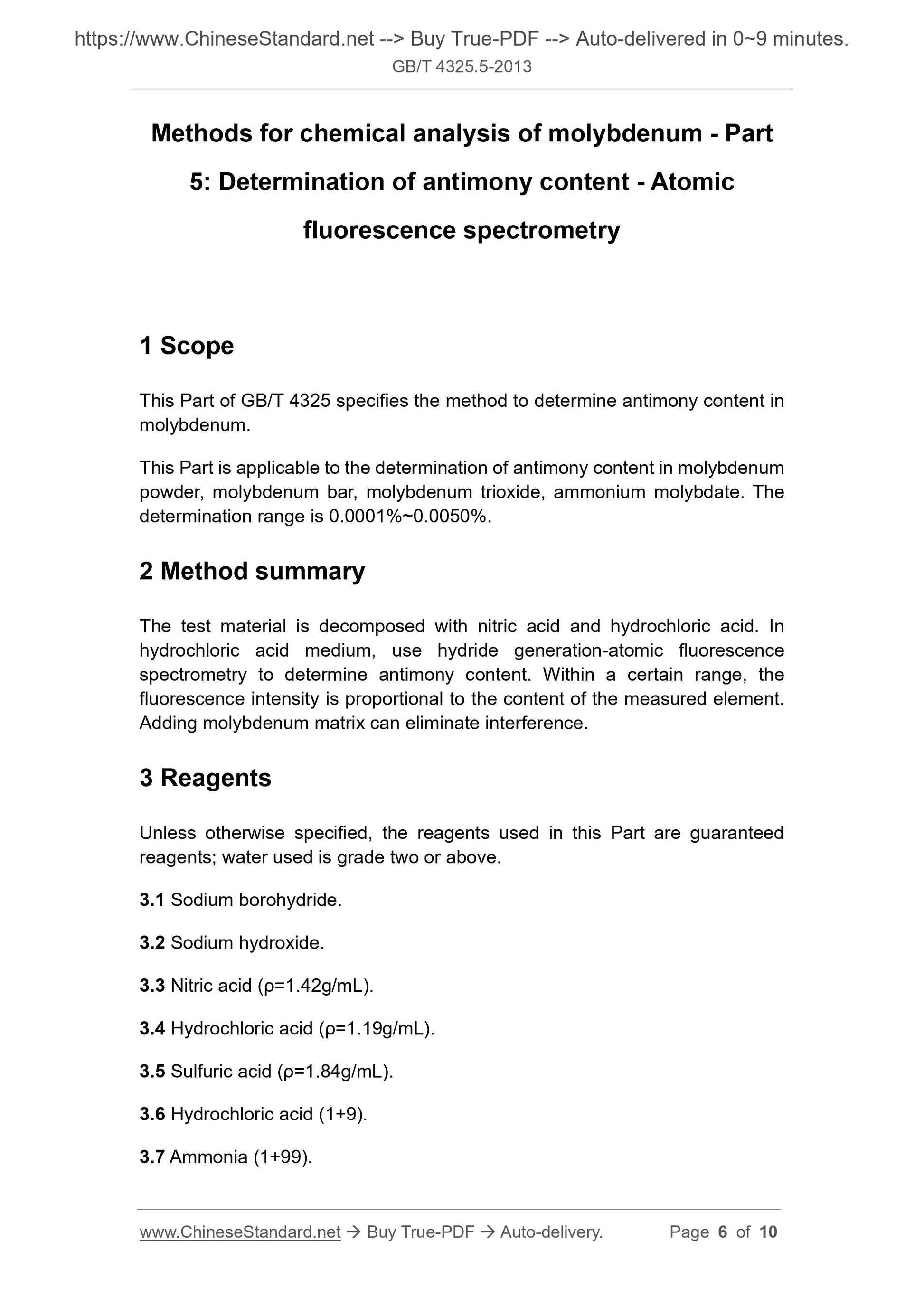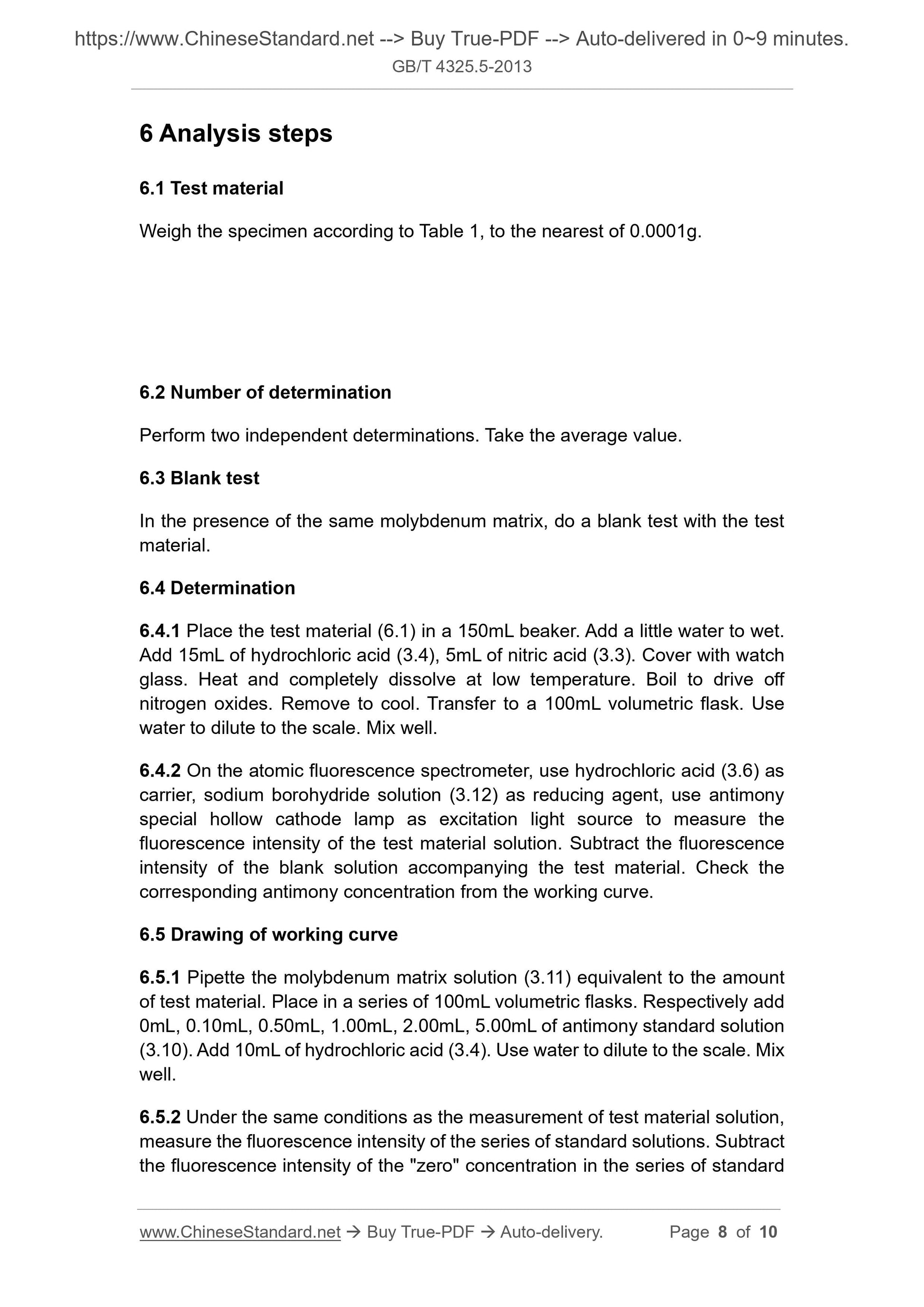1
/
of
5
www.ChineseStandard.us -- Field Test Asia Pte. Ltd.
GB/T 4325.5-2013 English PDF (GB/T4325.5-2013)
GB/T 4325.5-2013 English PDF (GB/T4325.5-2013)
Regular price
$130.00
Regular price
Sale price
$130.00
Unit price
/
per
Shipping calculated at checkout.
Couldn't load pickup availability
GB/T 4325.5-2013: Methods for chemical analysis of molybdenum - Part 5: Determination of antimony content - Atomic fluorescence spectrometry
Delivery: 9 seconds. Download (& Email) true-PDF + Invoice.
Get Quotation: Click GB/T 4325.5-2013 (Self-service in 1-minute)
Historical versions (Master-website): GB/T 4325.5-2013
Preview True-PDF (Reload/Scroll-down if blank)
GB/T 4325.5-2013
GB
NATIONAL STANDARD OF THE
PEOPLE’S REPUBLIC OF CHINA
ICS 77.120.99
H 63
Replacing GB/T 4325.4-1984
Methods for chemical analysis of molybdenum - Part
5: Determination of antimony content - Atomic
fluorescence spectrometry
ISSUED ON: MAY 09, 2013
IMPLEMENTED ON: FEBRUARY 01, 2014
Issued by: General Administration of Quality Supervision, Inspection and
Quarantine;
Standardization Administration of the People's Republic of
China.
Table of Contents
Foreword ... 3
1 Scope ... 6
2 Method summary ... 6
3 Reagents ... 6
4 Instruments ... 7
5 Specimen ... 7
6 Analysis steps ... 8
7 Calculation of analysis results ... 9
8 Precision ... 9
9 Test report ... 10
Foreword
GB/T 4325 “Methods for chemical analysis of molybdenum” consists of the
following 26 parts:
- Part 1: Determination of lead content - Graphite furnace atomic absorption
spectrometry;
- Part 2: Determination of cadmium content - Flame atomic absorption
spectrometry;
- Part 3: Determination of bismuth content - Atomic fluorescence
spectrometry;
- Part 4: Determination of tin content - Atomic fluorescence spectrometry;
- Part 5: Determination of antimony content - Atomic fluorescence
spectrometry;
- Part 6: Determination of arsenic content - Atomic fluorescence spectrometry;
- Part 7: Determination of iron content - 1,10-phenanthroline
spectrophotometry and inductively coupled plasma atomic emission
spectrometry;
- Part 8: Determination of cobalt content - 5-Cl-PADAB spectrophotometry
and flame atomic absorption spectrometry;
- Part 9: Determination of nickel content - Dimethylglyoxime
spectrophotometry and flame atomic absorption spectrometry;
- Part 10: Determination of copper content - Flame atomic absorption
spectrometry;
- Part 11: Determination of aluminum content – Chrome azurol S
spectrophotometry and inductively coupled plasma atomic emission
spectrometry;
- Part 12: Determination of silicon content - Inductively coupled plasma
atomic emission spectrometry;
- Part 13: Determination of calcium content - Flame atomic absorption
spectrometry;
- Part 14: Determination of magnesium content - Flame atomic absorption
spectrometry;
Methods for chemical analysis of molybdenum - Part
5: Determination of antimony content - Atomic
fluorescence spectrometry
1 Scope
This Part of GB/T 4325 specifies the method to determine antimony content in
molybdenum.
This Part is applicable to the determination of antimony content in molybdenum
powder, molybdenum bar, molybdenum trioxide, ammonium molybdate. The
determination range is 0.0001%~0.0050%.
2 Method summary
The test material is decomposed with nitric acid and hydrochloric acid. In
hydrochloric acid medium, use hydride generation-atomic fluorescence
spectrometry to determine antimony content. Within a certain range, the
fluorescence intensity is proportional to the content of the measured element.
Adding molybdenum matrix can eliminate interference.
3 Reagents
Unless otherwise specified, the reagents used in this Part are guaranteed
reagents; water used is grade two or above.
3.1 Sodium borohydride.
3.2 Sodium hydroxide.
3.3 Nitric acid (ρ=1.42g/mL).
3.4 Hydrochloric acid (ρ=1.19g/mL).
3.5 Sulfuric acid (ρ=1.84g/mL).
3.6 Hydrochloric acid (1+9).
3.7 Ammonia (1+99).
6 Analysis steps
6.1 Test material
Weigh the specimen according to Table 1, to the nearest of 0.0001g.
6.2 Number of determination
Perform two independent determinations. Take the average value.
6.3 Blank test
In the presence of the same molybdenum matrix, do a blank test with the test
material.
6.4 Determination
6.4.1 Place the test material (6.1) in a 150mL beaker. Add a little water to wet.
Add 15mL of hydrochloric acid (3.4), 5mL of nitric acid (3.3). Cover with watch
glass. Heat and completely dissolve at low temperature. Boil to drive off
nitrogen oxides. Remove to cool. Transfer to a 100mL volumetric flask. Use
water to dilute to the scale. Mix well.
6.4.2 On the atomic fluorescence spectrometer, use hydrochloric acid (3.6) as
carrier, sodium borohydride solution (3.12) as reducing agent, use antimony
special hollow cathode lamp as excitation light source to measure the
fluorescence intensity of the test material solution. Subtract the fluorescence
intensity of the blank solution accompanying the test material. Check the
corresponding antimony concentration from the working curve.
6.5 Drawing of working curve
6.5.1 Pipette the molybdenum matrix solution (3.11) equivalent to the amount
of test material. Place in a series of 100mL volumetric flasks. Respectively add
0mL, 0.10mL, 0.50mL, 1.00mL, 2.00mL, 5.00mL of antimony standard solution
(3.10). Add 10mL of hydrochloric acid (3.4). Use water to dilute to the scale. Mix
well.
6.5.2 Under the same conditions as the measurement of test material solution,
measure the fluorescence intensity of the series of standard solutions. Subtract
the fluorescence intensity of the "zero" concentration in the series of standard
GB/T 4325.5-2013
GB
NATIONAL STANDARD OF THE
PEOPLE’S REPUBLIC OF CHINA
ICS 77.120.99
H 63
Replacing GB/T 4325.4-1984
Methods for chemical analysis of molybdenum - Part
5: Determination of antimony content - Atomic
fluorescence spectrometry
ISSUED ON: MAY 09, 2013
IMPLEMENTED ON: FEBRUARY 01, 2014
Issued by: General Administration of Quality Supervision, Inspection and
Quarantine;
Standardization Administration of the People's Republic of
China.
Table of Contents
Foreword ... 3
1 Scope ... 6
2 Method summary ... 6
3 Reagents ... 6
4 Instruments ... 7
5 Specimen ... 7
6 Analysis steps ... 8
7 Calculation of analysis results ... 9
8 Precision ... 9
9 Test report ... 10
Foreword
GB/T 4325 “Methods for chemical analysis of molybdenum” consists of the
following 26 parts:
- Part 1: Determination of lead content - Graphite furnace atomic absorption
spectrometry;
- Part 2: Determination of cadmium content - Flame atomic absorption
spectrometry;
- Part 3: Determination of bismuth content - Atomic fluorescence
spectrometry;
- Part 4: Determination of tin content - Atomic fluorescence spectrometry;
- Part 5: Determination of antimony content - Atomic fluorescence
spectrometry;
- Part 6: Determination of arsenic content - Atomic fluorescence spectrometry;
- Part 7: Determination of iron content - 1,10-phenanthroline
spectrophotometry and inductively coupled plasma atomic emission
spectrometry;
- Part 8: Determination of cobalt content - 5-Cl-PADAB spectrophotometry
and flame atomic absorption spectrometry;
- Part 9: Determination of nickel content - Dimethylglyoxime
spectrophotometry and flame atomic absorption spectrometry;
- Part 10: Determination of copper content - Flame atomic absorption
spectrometry;
- Part 11: Determination of aluminum content – Chrome azurol S
spectrophotometry and inductively coupled plasma atomic emission
spectrometry;
- Part 12: Determination of silicon content - Inductively coupled plasma
atomic emission spectrometry;
- Part 13: Determination of calcium content - Flame atomic absorption
spectrometry;
- Part 14: Determination of magnesium content - Flame atomic absorption
spectrometry;
Methods for chemical analysis of molybdenum - Part
5: Determination of antimony content - Atomic
fluorescence spectrometry
1 Scope
This Part of GB/T 4325 specifies the method to determine antimony content in
molybdenum.
This Part is applicable to the determination of antimony content in molybdenum
powder, molybdenum bar, molybdenum trioxide, ammonium molybdate. The
determination range is 0.0001%~0.0050%.
2 Method summary
The test material is decomposed with nitric acid and hydrochloric acid. In
hydrochloric acid medium, use hydride generation-atomic fluorescence
spectrometry to determine antimony content. Within a certain range, the
fluorescence intensity is proportional to the content of the measured element.
Adding molybdenum matrix can eliminate interference.
3 Reagents
Unless otherwise specified, the reagents used in this Part are guaranteed
reagents; water used is grade two or above.
3.1 Sodium borohydride.
3.2 Sodium hydroxide.
3.3 Nitric acid (ρ=1.42g/mL).
3.4 Hydrochloric acid (ρ=1.19g/mL).
3.5 Sulfuric acid (ρ=1.84g/mL).
3.6 Hydrochloric acid (1+9).
3.7 Ammonia (1+99).
6 Analysis steps
6.1 Test material
Weigh the specimen according to Table 1, to the nearest of 0.0001g.
6.2 Number of determination
Perform two independent determinations. Take the average value.
6.3 Blank test
In the presence of the same molybdenum matrix, do a blank test with the test
material.
6.4 Determination
6.4.1 Place the test material (6.1) in a 150mL beaker. Add a little water to wet.
Add 15mL of hydrochloric acid (3.4), 5mL of nitric acid (3.3). Cover with watch
glass. Heat and completely dissolve at low temperature. Boil to drive off
nitrogen oxides. Remove to cool. Transfer to a 100mL volumetric flask. Use
water to dilute to the scale. Mix well.
6.4.2 On the atomic fluorescence spectrometer, use hydrochloric acid (3.6) as
carrier, sodium borohydride solution (3.12) as reducing agent, use antimony
special hollow cathode lamp as excitation light source to measure the
fluorescence intensity of the test material solution. Subtract the fluorescence
intensity of the blank solution accompanying the test material. Check the
corresponding antimony concentration from the working curve.
6.5 Drawing of working curve
6.5.1 Pipette the molybdenum matrix solution (3.11) equivalent to the amount
of test material. Place in a series of 100mL volumetric flasks. Respectively add
0mL, 0.10mL, 0.50mL, 1.00mL, 2.00mL, 5.00mL of antimony standard solution
(3.10). Add 10mL of hydrochloric acid (3.4). Use water to dilute to the scale. Mix
well.
6.5.2 Under the same conditions as the measurement of test material solution,
measure the fluorescence intensity of the series of standard solutions. Subtract
the fluorescence intensity of the "zero" concentration in the series of standard
Delivery: 9 seconds. Download (& Email) true-PDF + Invoice.
Get Quotation: Click GB/T 4325.5-2013 (Self-service in 1-minute)
Historical versions (Master-website): GB/T 4325.5-2013
Preview True-PDF (Reload/Scroll-down if blank)
GB/T 4325.5-2013
GB
NATIONAL STANDARD OF THE
PEOPLE’S REPUBLIC OF CHINA
ICS 77.120.99
H 63
Replacing GB/T 4325.4-1984
Methods for chemical analysis of molybdenum - Part
5: Determination of antimony content - Atomic
fluorescence spectrometry
ISSUED ON: MAY 09, 2013
IMPLEMENTED ON: FEBRUARY 01, 2014
Issued by: General Administration of Quality Supervision, Inspection and
Quarantine;
Standardization Administration of the People's Republic of
China.
Table of Contents
Foreword ... 3
1 Scope ... 6
2 Method summary ... 6
3 Reagents ... 6
4 Instruments ... 7
5 Specimen ... 7
6 Analysis steps ... 8
7 Calculation of analysis results ... 9
8 Precision ... 9
9 Test report ... 10
Foreword
GB/T 4325 “Methods for chemical analysis of molybdenum” consists of the
following 26 parts:
- Part 1: Determination of lead content - Graphite furnace atomic absorption
spectrometry;
- Part 2: Determination of cadmium content - Flame atomic absorption
spectrometry;
- Part 3: Determination of bismuth content - Atomic fluorescence
spectrometry;
- Part 4: Determination of tin content - Atomic fluorescence spectrometry;
- Part 5: Determination of antimony content - Atomic fluorescence
spectrometry;
- Part 6: Determination of arsenic content - Atomic fluorescence spectrometry;
- Part 7: Determination of iron content - 1,10-phenanthroline
spectrophotometry and inductively coupled plasma atomic emission
spectrometry;
- Part 8: Determination of cobalt content - 5-Cl-PADAB spectrophotometry
and flame atomic absorption spectrometry;
- Part 9: Determination of nickel content - Dimethylglyoxime
spectrophotometry and flame atomic absorption spectrometry;
- Part 10: Determination of copper content - Flame atomic absorption
spectrometry;
- Part 11: Determination of aluminum content – Chrome azurol S
spectrophotometry and inductively coupled plasma atomic emission
spectrometry;
- Part 12: Determination of silicon content - Inductively coupled plasma
atomic emission spectrometry;
- Part 13: Determination of calcium content - Flame atomic absorption
spectrometry;
- Part 14: Determination of magnesium content - Flame atomic absorption
spectrometry;
Methods for chemical analysis of molybdenum - Part
5: Determination of antimony content - Atomic
fluorescence spectrometry
1 Scope
This Part of GB/T 4325 specifies the method to determine antimony content in
molybdenum.
This Part is applicable to the determination of antimony content in molybdenum
powder, molybdenum bar, molybdenum trioxide, ammonium molybdate. The
determination range is 0.0001%~0.0050%.
2 Method summary
The test material is decomposed with nitric acid and hydrochloric acid. In
hydrochloric acid medium, use hydride generation-atomic fluorescence
spectrometry to determine antimony content. Within a certain range, the
fluorescence intensity is proportional to the content of the measured element.
Adding molybdenum matrix can eliminate interference.
3 Reagents
Unless otherwise specified, the reagents used in this Part are guaranteed
reagents; water used is grade two or above.
3.1 Sodium borohydride.
3.2 Sodium hydroxide.
3.3 Nitric acid (ρ=1.42g/mL).
3.4 Hydrochloric acid (ρ=1.19g/mL).
3.5 Sulfuric acid (ρ=1.84g/mL).
3.6 Hydrochloric acid (1+9).
3.7 Ammonia (1+99).
6 Analysis steps
6.1 Test material
Weigh the specimen according to Table 1, to the nearest of 0.0001g.
6.2 Number of determination
Perform two independent determinations. Take the average value.
6.3 Blank test
In the presence of the same molybdenum matrix, do a blank test with the test
material.
6.4 Determination
6.4.1 Place the test material (6.1) in a 150mL beaker. Add a little water to wet.
Add 15mL of hydrochloric acid (3.4), 5mL of nitric acid (3.3). Cover with watch
glass. Heat and completely dissolve at low temperature. Boil to drive off
nitrogen oxides. Remove to cool. Transfer to a 100mL volumetric flask. Use
water to dilute to the scale. Mix well.
6.4.2 On the atomic fluorescence spectrometer, use hydrochloric acid (3.6) as
carrier, sodium borohydride solution (3.12) as reducing agent, use antimony
special hollow cathode lamp as excitation light source to measure the
fluorescence intensity of the test material solution. Subtract the fluorescence
intensity of the blank solution accompanying the test material. Check the
corresponding antimony concentration from the working curve.
6.5 Drawing of working curve
6.5.1 Pipette the molybdenum matrix solution (3.11) equivalent to the amount
of test material. Place in a series of 100mL volumetric flasks. Respectively add
0mL, 0.10mL, 0.50mL, 1.00mL, 2.00mL, 5.00mL of antimony standard solution
(3.10). Add 10mL of hydrochloric acid (3.4). Use water to dilute to the scale. Mix
well.
6.5.2 Under the same conditions as the measurement of test material solution,
measure the fluorescence intensity of the series of standard solutions. Subtract
the fluorescence intensity of the "zero" concentration in the series of standard
GB/T 4325.5-2013
GB
NATIONAL STANDARD OF THE
PEOPLE’S REPUBLIC OF CHINA
ICS 77.120.99
H 63
Replacing GB/T 4325.4-1984
Methods for chemical analysis of molybdenum - Part
5: Determination of antimony content - Atomic
fluorescence spectrometry
ISSUED ON: MAY 09, 2013
IMPLEMENTED ON: FEBRUARY 01, 2014
Issued by: General Administration of Quality Supervision, Inspection and
Quarantine;
Standardization Administration of the People's Republic of
China.
Table of Contents
Foreword ... 3
1 Scope ... 6
2 Method summary ... 6
3 Reagents ... 6
4 Instruments ... 7
5 Specimen ... 7
6 Analysis steps ... 8
7 Calculation of analysis results ... 9
8 Precision ... 9
9 Test report ... 10
Foreword
GB/T 4325 “Methods for chemical analysis of molybdenum” consists of the
following 26 parts:
- Part 1: Determination of lead content - Graphite furnace atomic absorption
spectrometry;
- Part 2: Determination of cadmium content - Flame atomic absorption
spectrometry;
- Part 3: Determination of bismuth content - Atomic fluorescence
spectrometry;
- Part 4: Determination of tin content - Atomic fluorescence spectrometry;
- Part 5: Determination of antimony content - Atomic fluorescence
spectrometry;
- Part 6: Determination of arsenic content - Atomic fluorescence spectrometry;
- Part 7: Determination of iron content - 1,10-phenanthroline
spectrophotometry and inductively coupled plasma atomic emission
spectrometry;
- Part 8: Determination of cobalt content - 5-Cl-PADAB spectrophotometry
and flame atomic absorption spectrometry;
- Part 9: Determination of nickel content - Dimethylglyoxime
spectrophotometry and flame atomic absorption spectrometry;
- Part 10: Determination of copper content - Flame atomic absorption
spectrometry;
- Part 11: Determination of aluminum content – Chrome azurol S
spectrophotometry and inductively coupled plasma atomic emission
spectrometry;
- Part 12: Determination of silicon content - Inductively coupled plasma
atomic emission spectrometry;
- Part 13: Determination of calcium content - Flame atomic absorption
spectrometry;
- Part 14: Determination of magnesium content - Flame atomic absorption
spectrometry;
Methods for chemical analysis of molybdenum - Part
5: Determination of antimony content - Atomic
fluorescence spectrometry
1 Scope
This Part of GB/T 4325 specifies the method to determine antimony content in
molybdenum.
This Part is applicable to the determination of antimony content in molybdenum
powder, molybdenum bar, molybdenum trioxide, ammonium molybdate. The
determination range is 0.0001%~0.0050%.
2 Method summary
The test material is decomposed with nitric acid and hydrochloric acid. In
hydrochloric acid medium, use hydride generation-atomic fluorescence
spectrometry to determine antimony content. Within a certain range, the
fluorescence intensity is proportional to the content of the measured element.
Adding molybdenum matrix can eliminate interference.
3 Reagents
Unless otherwise specified, the reagents used in this Part are guaranteed
reagents; water used is grade two or above.
3.1 Sodium borohydride.
3.2 Sodium hydroxide.
3.3 Nitric acid (ρ=1.42g/mL).
3.4 Hydrochloric acid (ρ=1.19g/mL).
3.5 Sulfuric acid (ρ=1.84g/mL).
3.6 Hydrochloric acid (1+9).
3.7 Ammonia (1+99).
6 Analysis steps
6.1 Test material
Weigh the specimen according to Table 1, to the nearest of 0.0001g.
6.2 Number of determination
Perform two independent determinations. Take the average value.
6.3 Blank test
In the presence of the same molybdenum matrix, do a blank test with the test
material.
6.4 Determination
6.4.1 Place the test material (6.1) in a 150mL beaker. Add a little water to wet.
Add 15mL of hydrochloric acid (3.4), 5mL of nitric acid (3.3). Cover with watch
glass. Heat and completely dissolve at low temperature. Boil to drive off
nitrogen oxides. Remove to cool. Transfer to a 100mL volumetric flask. Use
water to dilute to the scale. Mix well.
6.4.2 On the atomic fluorescence spectrometer, use hydrochloric acid (3.6) as
carrier, sodium borohydride solution (3.12) as reducing agent, use antimony
special hollow cathode lamp as excitation light source to measure the
fluorescence intensity of the test material solution. Subtract the fluorescence
intensity of the blank solution accompanying the test material. Check the
corresponding antimony concentration from the working curve.
6.5 Drawing of working curve
6.5.1 Pipette the molybdenum matrix solution (3.11) equivalent to the amount
of test material. Place in a series of 100mL volumetric flasks. Respectively add
0mL, 0.10mL, 0.50mL, 1.00mL, 2.00mL, 5.00mL of antimony standard solution
(3.10). Add 10mL of hydrochloric acid (3.4). Use water to dilute to the scale. Mix
well.
6.5.2 Under the same conditions as the measurement of test material solution,
measure the fluorescence intensity of the series of standard solutions. Subtract
the fluorescence intensity of the "zero" concentration in the series of standard
Share
